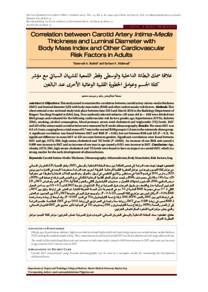Document
Correlation between carotid artery intima-media thickness and luminal diameter with body mass index and other cardiovascular risk factors in adults.
Identifier
doi: 10.18295/squmj.2015.15.03.007
Contributors
Mahmud, Sarbast A., Author
Other titles
علاقة سمك البطانة الداخلية والوسطى وقطر اللمعية للشريان السباتي مع مؤشر كتلة الجسم وعوامل الخطورة القلبية الوعائية الأخرى عند البالغين
Publisher
College of Medicine, Sultan Qaboos University.
Gregorian
2015-08
Language
English
English abstract
Objectives: This study aimed to examine the correlation between carotid artery intima-media thickness (IMT) and luminal diameter (LD) with body mass index (BMI) and other cardiovascular risk factors. Methods: This observational cross-sectional study took place between June 2013 and March 2014 in the Radiology Department of Rizgary Teaching Hospital in Erbil, Iraq. Non-randomly selected subjects ≥20 years old (n = 140) were divided into BMI groups and evaluated for the following cardiovascular risk factors: gender, age, hypertension (HTN), diabetes (DM), smoking, alcohol consumption, blood pressure, serum total cholesterol and triglyceride (TG) levels. IMT and LD of the extracranial carotid arteries were measured by B-mode ultrasonography. Results: The mean IMT was 0.8 ± 0.3 mm, ranging from a total mean of 0.7 mm in the normal BMI group to 1.0 mm in the extremely obese group. A significant correlation was found between IMT and BMI (P = 0.04), but not between BMI and LD (P = 0.3). No significant difference in mean IMT or LD was seen between genders. Significant correlations were found between IMT and age, HTN, DM, high serum cholesterol and TG levels (P <0.001). An increase of one BMI unit caused a 0.009 mm increase in IMT and an increase of one year in age caused a 0.011 mm increase in IMT. Conclusion: Age, obesity, HTN, DM, high serum cholesterol and TG levels were found to have an impact on carotid IMT, which is a strong marker for the early development of atherosclerosis.
Member of
Resource URL
Arabic abstract
تهدف هذه الدراسة إلى فحص العلاقة بين سمك البطانة الداخلية والوسطى (IMT) وقطر اللمعية (LD) للشريان السباتي مع مؤشر كتلة الجسم وغيرها من عوامل الخطورة القلبية الوعائية. الطريقة: أجريت هذه الدراسة مستعرضة الرصد في الفترة ما بين يونيو 2013 ومارس 2014 في قسم الأشعة في مستشفى رزكاري التعليمي في أربيل، بالعراق. وتم تقسيم الحالات المختارة بطريقة غير عشوائية 20≥سنة (140 حالة) إلى مجموعات (BMI) وقسمت عوامل الخطر القلبية الوعائية كالتالي: نوع الجنس، السن، ارتفاع ضغط الدم (HNT)، مرض السكري(DM)، التدخين واستهلاك الكحول، ومستويات الكولسترول الكلي والدهون الثلاثية (TG) في الدم. وتم قياس IMT كانت 0.8 ± 0.3 مم، بدءا من المعدل الكلي ل0.7 مم في مجموعة BMI العادية ل1.0 مم في المجموعة ذات السمنة المفرطة للغاية. تم العثور على ارتباط وثيق بين IMT و PMI (P = 0.04) ولكن ليس بين مؤشري كتلة الجسم و LD (P = 0.3). ولم يوجد فرق كبير في متوسط IMT و LD بين الجنسين. تم العثور على ارتباط كبيربين IMT والعمر، HNT، DM، ارتفاع نسبة الكولسترول و TG في الدم (P <0.001). وقد لوحظ أن زيادة وحدة واحدة لPMI تسبب في زيادة 0.009 مم في IMT وزيادة سنة واحدة في العمر تؤدي إلى زيادة 0.011 مم في IMT. الخلاصة: خلصت الدراسة إلأى أن العمر والسمنة و HTN، وارتفاع نسبة الكولسترول وDM ومستويات TG في الدم لها تأثير معنوي على IMT للشريان السباتي، والذي يعتبر مؤشرا قويا للنشوء المبكر لتصلب الشرايين.
Category
Journal articles

